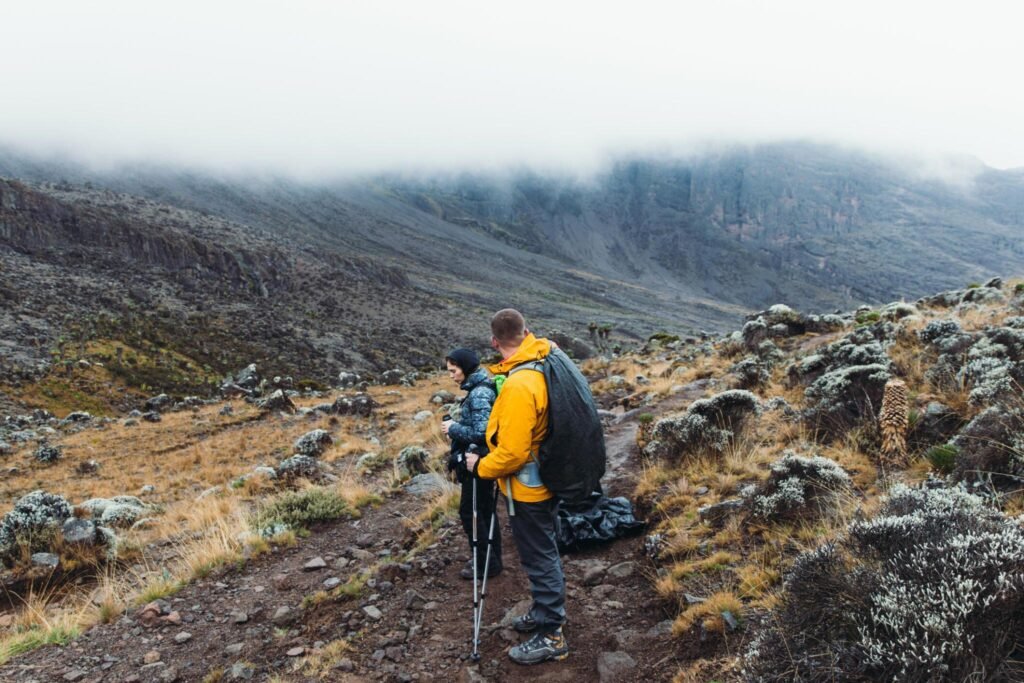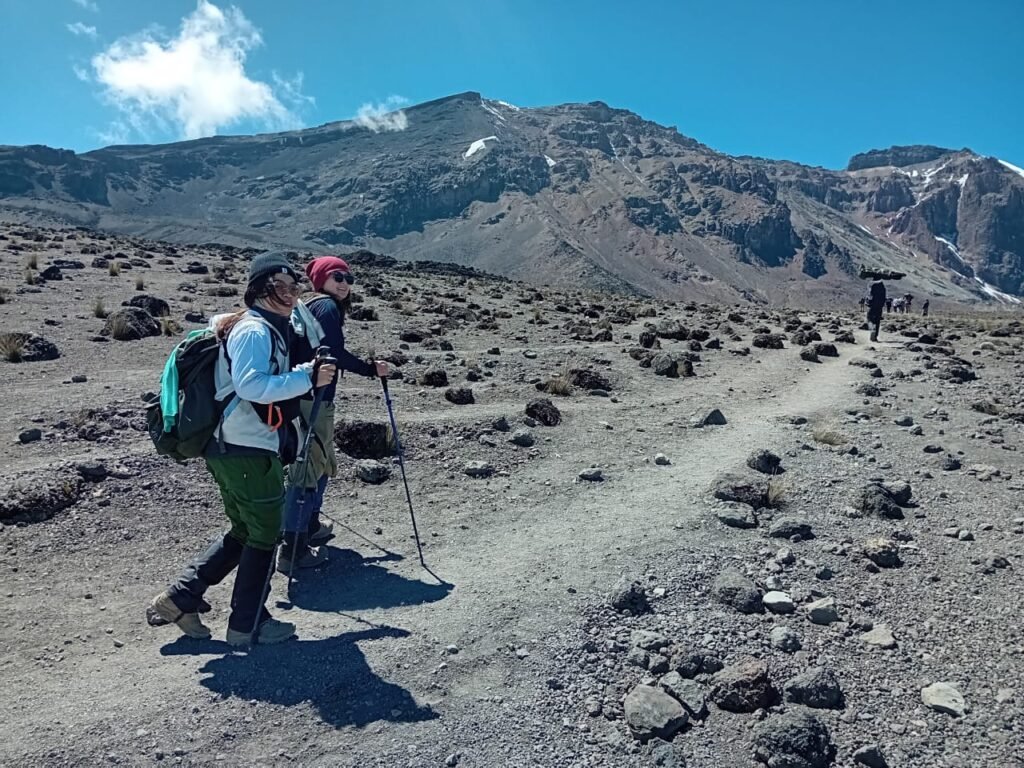8-Day Lemosho Route Climb Package is renowned for being one of the most beautiful and remote ways to summit Mount Kilimanjaro. Stretching over 8 days, this scenic trek allows for gradual acclimatization and offers a higher success rate compared to shorter routes. Known for its lush forests, panoramic views, and diverse landscapes, the Lemosho Route provides trekkers with an unforgettable journey to the top of Africa’s tallest mountain.

In this guide, we’ll walk you through everything you need to know about the 8-day Lemosho Route Climb Package for 2025, from route highlights to preparing for your adventure.
8-Day Lemosho Route Climb Package Why Choose ?
8-Day Lemosho Route Climb Package is highly favored by trekkers due to its scenic beauty, fewer crowds, and excellent acclimatization opportunities. Here’s why it’s an ideal choice for your Kilimanjaro trek in 2025:
1. Stunning and Varied Landscapes
Starting from the lush rainforests on the western side of Kilimanjaro, the Lemosho Route traverses through diverse ecosystems—from the Shira Plateau to alpine deserts and the summit’s snow-capped peaks. Each day offers something new and breathtaking.
- Rainforest Zone: Begin your trek surrounded by towering trees and diverse wildlife, including colobus monkeys.
- Shira Plateau: Experience open vistas and volcanic rock formations as you trek across this stunning high-altitude plateau.
- Alpine Desert: A stark but beautiful region that showcases Kilimanjaro’s vast, barren landscapes.
- Summit: Reach the glacier-capped Uhuru Peak, standing tall at 5,895 meters.
Explore more about Kilimanjaro’s ecosystems in National Geographic’s guide to Kilimanjaro.
2. Excellent Acclimatization Profile
The Lemosho Route is known for its “climb high, sleep low” approach, which helps reduce the risk of altitude sickness. With more time for acclimatization, this 8-day itinerary gives trekkers a better chance of reaching the summit successfully.
Learn more about how acclimatization impacts your summit chances from the Altitude Research Center.
3. Fewer Crowds
Compared to busier routes like Machame or Marangu, the Lemosho Route is less crowded, particularly in the early stages of the trek. This offers a more peaceful and intimate experience as you make your way to the summit.
For a quieter, more immersive experience on Kilimanjaro, the Lemosho Route is the perfect choice. Check out the full package details at Kilimanjaro Climb Specialist.
8-Day Lemosho Route Climb Package : Day-by-Day Breakdown
This 8-day package is designed to give you ample time for acclimatization while ensuring you experience the beauty and challenge of Kilimanjaro. Below is the day-by-day breakdown of the Lemosho Route itinerary:
Day 1: Londorossi Gate to Mti Mkubwa Camp (7 km)
- Elevation: 2,100 meters to 2,650 meters
- Trekking Time: 3-4 hours
Your journey begins at Londorossi Gate, where you’ll trek through dense rainforest, arriving at Mti Mkubwa Camp for your first night. Be prepared to see some of Kilimanjaro’s wildlife, including monkeys and various bird species.
Learn more about the rich biodiversity of Kilimanjaro’s rainforests at World Wildlife Fund’s Kilimanjaro profile.
Day 2: Mti Mkubwa to Shira 1 Camp (8 km)
- Elevation: 2,650 meters to 3,610 meters
- Trekking Time: 5-6 hours
Trek out of the forest and onto the expansive Shira Plateau, where you’ll enjoy incredible views of Kibo Peak and the surrounding landscapes. You’ll camp at Shira 1 Camp under the vast African sky.
Day 3: Shira 1 Camp to Shira 2 Camp (6 km)
- Elevation: 3,610 meters to 3,850 meters
- Trekking Time: 3-4 hours
Enjoy a shorter trek across the plateau to Shira 2 Camp, with time to rest and acclimatize. The landscape transitions to more open, volcanic terrain, with panoramic views that stretch for miles.
For more about Kilimanjaro’s volcanic history, visit Geology.com’s Kilimanjaro page.
Day 4: Shira 2 Camp to Barranco Camp via Lava Tower (10 km)
- Elevation: 3,850 meters to 4,600 meters (Lava Tower), descending to 3,960 meters
- Trekking Time: 7-8 hours
This is a critical acclimatization day. You’ll ascend to Lava Tower before descending to Barranco Camp. This “climb high, sleep low” approach will help your body adjust to the altitude.
Learn more about the importance of acclimatization at Altitude.org’s acclimatization guide.
Day 5: Barranco Camp to Karanga Camp (5 km)
- Elevation: 3,960 meters to 4,035 meters
- Trekking Time: 4-5 hours
The highlight of the day is climbing the Barranco Wall, a non-technical but challenging ascent that rewards you with incredible views. You’ll trek to Karanga Camp for the night.
Day 6: Karanga Camp to Barafu Camp (4 km)
- Elevation: 4,035 meters to 4,673 meters
- Trekking Time: 3-4 hours
Today’s trek is relatively short, giving you time to rest and prepare for the summit attempt. You’ll arrive at Barafu Camp, the base camp for your summit push.
Day 7: Barafu Camp to Uhuru Peak (5.7 km), Descend to Mweka Camp (12 km)
- Elevation: 4,673 meters to 5,895 meters (Uhuru Peak), descending to 3,100 meters
- Trekking Time: 12-14 hours
Summit night begins around midnight, with a slow and steady ascent to the summit of Uhuru Peak, the highest point in Africa. After celebrating your achievement at the top, you’ll begin your descent to Mweka Camp.
Day 8: Mweka Camp to Mweka Gate (10 km)
- Elevation: 3,100 meters to 1,640 meters
- Trekking Time: 3-4 hours
Your final day on the mountain is a gentle descent through the rainforest, where you’ll complete your trek at Mweka Gate. Here, you’ll receive your well-earned summit certificate before returning to Moshi.

8-Day Lemosho Route Climb Package : What’s Included ?
This 8-day Lemosho Route climb package includes everything you need for a successful and memorable trek to the summit of Mount Kilimanjaro:
1. Expert Guides and Porters
You’ll be accompanied by certified, experienced guides who know the Lemosho Route inside and out. Porters will carry your gear, allowing you to focus on the climb.
For more about the importance of having expert guides and porters, visit Eddy Tours & Safaris.
2. All Meals and Drinking Water
You’ll be provided with freshly prepared meals throughout the trek, ensuring you have the energy needed to reach the summit. Safe, clean drinking water will be available throughout the climb.
3. High-Quality Camping Equipment
Camping on the Lemosho Route is made comfortable with high-quality tents, sleeping pads, and dining equipment. You’ll stay in comfortable, weather-proof tents at each camp.
4. Kilimanjaro National Park Fees
Your package covers all necessary park fees and permits, giving you access to the pristine beauty of Kilimanjaro National Park.
For more about the park’s conservation efforts, visit UNESCO’s Kilimanjaro World Heritage site.
5. Safety Equipment
Your safety is the top priority. Your package includes essential safety equipment like oxygen tanks, first-aid kits, and daily health checks to monitor your well-being at high altitudes.
For more tips on staying safe while trekking, read Outdoor Gear Lab’s trekking safety guide.
8-Day Lemosho Route Climb Package : Preparing for Your 8-Day Lemosho Route Climb
1. Physical Fitness
Climbing Kilimanjaro requires a good level of fitness, particularly for the longer Lemosho Route. To prepare, focus on cardio exercises, strength training, and hiking with a weighted backpack to simulate the conditions of the trek.
Check out this Kilimanjaro fitness training guide for detailed workout plans.
2. Mental Preparation
Summit night can be physically and mentally exhausting. Stay positive and focused on your goal. Mental toughness is just as important as physical stamina when climbing Kilimanjaro.
3. Essential Gear Checklist
Packing the right gear is essential for a successful climb. Here are some must-have items for your trek:
- Waterproof hiking boots (well-broken in)
- Thermal layers for warmth at higher altitudes
- Waterproof jacket and pants to protect against rain and wind
- Trekking poles for stability on steep terrain
- Sunscreen and sunglasses for protection from UV rays at high altitudes
For a full packing list, visit Ultimate Kilimanjaro’s gear guide.
8-Day Lemosho Route Climb Package : Frequently Asked Questions (FAQs)
1. How difficult is the Lemosho Route?
The Lemosho Route is considered a moderate trek, but it’s still physically demanding due to the high altitude and long trekking days. The 8-day itinerary helps with acclimatization, making it more manageable.
2. What is the success rate of the Lemosho Route?
The success rate of the Lemosho Route is around 90%, thanks to its gradual ascent and ample time for acclimatization.
3. Do I need technical climbing skills for the Lemosho Route?
No, the Lemosho Route is a non-technical trek. However, you do need good physical fitness and mental endurance to reach the summit.
4. When is the best time to climb Kilimanjaro?
The best time to climb Kilimanjaro is during the dry seasons: January to March and June to October. These months offer more stable weather and clearer skies.
For more on Kilimanjaro’s climate, visit BBC’s Kilimanjaro climate guide.
5. Can I join a group climb on the Lemosho Route?
Yes, the Lemosho Route is a great option for group climbs. Solo travelers are welcome to join, and group climbs offer an excellent way to meet new people and share the experience.
8-Day Lemosho Route Climb Package conclusion
For more information or to book your 8-Day Lemosho Route Kilimanjaro Climb Package, visit Kilimanjaro Climb Specialist and Eddy Tours & Safaris.

